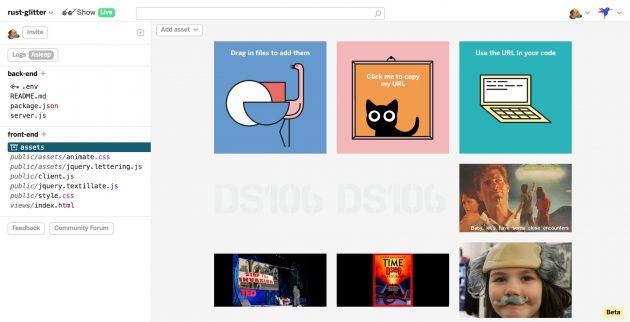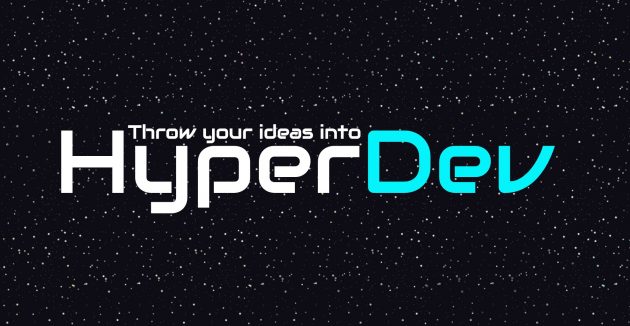Prefixing many words with “Hyper” makes them more interesting. Go from ordinary space into Hyperspace. Leave the everyday 3 dimensions of a cube for a Hypercube. What Apple did for me and many of us with a card on a little square computer? Hypercard.
(okay my wordplay goes bad for medical conditions, as a diabetic, I can tell you there is not anything more interesting about taking good glucose levels hyperglycemia, and likewise, having hypertension is not more interesting than any other kind of tension).
I caught wind of a new Hyper that I sensed would be interesting, HyperDev “a developer playground for building full-stack web-apps fast”. I suggest starting where I did, with Joel “on Software” Spolsky’s post on Introducing HyperDev:
HyperDev is going to be the fastest way to bang out code and get it running on the internet. We want to eliminate 100% of the complicated administrative details around getting code up and running on a website. The best way to explain that is with a little tour.
Step one. You go to hyperdev.com.
Boom. Your new website is already running. You have your own private virtual machine (well, really it’s a container but you don’t have to care about that or know what that means) running on the internet at its own, custom URL which you can already give people and they can already go to it and see the simple code we started you out with.
All that happened just because you went to hyperdev.com.
Notice what you DIDN’T do.
You didn’t make an account.
You didn’t use Git. Or any version control, really.
You didn’t deal with name servers.
You didn’t sign up with a hosting provider.
You didn’t provision a server.
You didn’t install an operating system or a LAMP stack or Node or operating systems or anything.
You didn’t configure the server.
You didn’t figure out how to integrate and deploy your code.
This connects to a tweet a few days ago from Ben Werdmüller:
https://twitter.com/benwerd/status/738035361918525440
It’s not a statement to agree/disagree with (I find myself doing both at once). But my response is that I don’t care about trying to get all or most people to do anything, I’ll just aim for more people.
And we come circling back the next day when Ben tweets
https://twitter.com/benwerd/status/738266791021936640
The only way I can feel somewhere in the direction of “comfortable” in talking about technology is to do something with it. I have been doing a few experiments in the last few months with hosting things in GitHub (though my flickr cc attribution helper is older, I had not gone too deep in GitHub as a place to publish to the web).
While GitHub is great, it is also baffling to many (I am on the toe of the learning cliff), and my experiments to get people to do the simplest, goofy forking have fallen flat (Adam Croom has done much better with getting folks to fork his GitHub hosted syllabus).
A year ago, I was pretty upbeat about the nifty way one could host a static web site from their own computer with surge.sh… then I forgot about it.
HyperDev is by no means much more approachable to people who shriek at the sight of naked HTML. It is no Big Magic Easy Button for getting your stuff on the web. It is still coding.
But… it’s… neat.
You more or less get your own little containerized web server, one that is already running Node.js (though you need not to do anything that depends on it). You edit/upload HTML, CSS, Javascript, and media. As you edit your code, the server more or less magically reboots/rejigs so you see the changes in real time.
It’s less a way to “get stuff easily on the web” as a near effortless way to build (some kinds of) web content in a rapid fashion. It’s got a way to invite collaborators to code with you, and not getting caught up in forks and merge messes.
It’s a place to mess around, or as Joel describes:
As developers we have fantastic sets of amazing tools for building, creating, managing, testing, and deploying our source code. They’re powerful and can do anything you might need. But they’re usually too complex and too complicated for very simple projects. Useful little bits of code never get written because you dread the administration of setting up a new dev environment, source code repo, and server. New programmers and students are overwhelmed by the complexity of distributed version control when they’re still learning to write a while loop. Apps that might solve real problems never get written because of the friction of getting started.
Our theory here is that HyperDev can remove all the barriers to getting started and building useful things, and more great things will get built.
I like that theory.
What I did is hardly useful or great, but damnit, I have to do more than “hello world”. It lives now at https://rust-glitter.hyperdev.space/ (HyperDev gives you a random word pair for a domain, custom domains are in the works).
You cannot see a static screenshot, but on the live HyperDev hosted site the background images reload and float by, and the top headline text animates.
I used one of the open licensed static HTML themes from HTML5.up (it’s the one called “Eventually”) and I tinkered with a jQuery code that animates text — textillate.js.
Here is my HyperDev environment:

You can upload, or code from scratch, any HTML, Javascript, CSS files in the “front end” area. At first I thought I had to get all the nested code in the 2 bits of code I used into the top level directory. But then on the HyperDev support forum, I was told I could create a directory structure simply by editing the file name (inserting a directory name).
The editor does a lot to keep you clean, auto-indenting, tag completion (for HTML), red error indicators for code. And you just click the “Look” button to spawn the public view of your project in another browser tab.
Media assets are drag/drop uploaded- mine are all images.

You click each one to get their URL – here is the link for the Time Magazine remix cover for DS106 is a Cult (I am pretty sure that Martha Burtis genius-ed that cover).
For anyone that might possibly care, the idea for this winds it’s way back to… no surprise, a DS106 Daily Create. Mariana Funes added some meme text to a photo Jim Groom tweeted with his new “cat”
@ds106dc #ds106 Daily create for #tdc1607 my response: You had one DS106 job 😉 @jimgroom pic.twitter.com/8LmCXVGFon
— Mariana (@mdvfunes) June 2, 2016
I felt compelled for indeterminate reasons to remix this photo to the classic James Bond villain Ernst Blofeld, who was always stroking his white cat while doing things to destroy the world (leading to Dr Evil for Austin Powers fans)
This calls for the #bond106 the classic Blofeld remade pic.twitter.com/qm6jbDOQsb
— Alan Levine (@cogdog) June 2, 2016
And here is where the DS106 magic really happens. One of my students from the Spring 2012 class I taught at University of Mary Washington (yes four years ago), @AnalyticD, not only remixed my image, but added a silly meme reference to what we were doing in 2012 (I leave it to the reader to look up “catbreading” but it was a “thing” in DS106 in 2012)
FIXED pic.twitter.com/5TvNk6UkcH
— FULLNODE is already root (@AnalyticD) June 2, 2016
Let me repeat that, a student in my class 4 years ago, is still tapped into, and creating stuff in DS106. Why? You’d have to ask them. I have my own theory…
And that leads to Jim piping in, as he does:
Catbreading #4life, #ds106 is a cult, not a class!
— Jim Groom (@jimgroom) June 2, 2016
That phrase “#ds106 is a cult, not a class!” got my mind visualizing something about “classy cults”; I had no idea what or if I would make anything (as so far, me and two other people in the internet were engaged in this thing, and I bet they both already forgot about it).
Bingo! Make something in HyperDev.
The fact that anyone can make a copy (aka fork) of my project from a link on the public site, rings to me as having some potential for SPLOT like things.
There’s more. While rumbling around the HyperDev community site (hosted in discourse), I came across this tutorial by a user named Nancy on HyperDev that is built and runs in HyperDev. You make/fork your own copy, then experiment with the four exercises, and learn as you try things.
I cannot offer a promise that HyperDev will be anyone’s magical Sea Monkeys for getting into web development. Heck, I am only 1 small step inside myself.
But there is something HyperNeat there.
Top / Featured Image: I have so many associations with words that begin with “Hyper”; I just started with a Google Images Search (set for images licensed for reuse, please tell me you use that option, please tell me you use that option, please…) on “hyperspace”.
Of course there were plenty of blurred stars converging to a point, right out of Star Wars, and I could have easily grabbed one and started blogging, but I just had to scroll.
This image, a flickr photo by dvanzuijlekom https://flickr.com/photos/dvanzuijlekom/15423697557 shared under a Creative Commons (BY-SA) license – works for be better because it is anchored in reality. The caption on the flickr page is worth it just for the scifi references. I’m a fan of interesting captions on photos, or for that matter, any caption.
Enjoy.
My colleagues of the Belastingdienst AIX/Linux Midrange Systems team and myself went on a teambuilding exercise. I took my camera of course. We went to Dorhout Mees for skeet shooting (kleiduivenschieten) and we were transported by Havi Travel in one of their luxurious coaches used primarily for transporting the SBV Vitesse football players.
The coach is equipped with an onboard kitchen, two refrigerators, multimedia system, wireless internet access and power outlets per passenger. An onboard generator provides all the electronics with power and is probably also used to either charge the flux capacitor or energize the dilithium crystals.
This picture was taken at the exact moment we exited from hyperspace.




I like the “rust-glitter” URL. It makes me think of some sort of Neil Young/glam rock mash-up.
I can’t take credit it was randomly assigned but yes indeed it is a Neilish URL
Hmm I need to play around with this. I know HTML might far out of the scope in which a SPLOT can exist, but it sort of looks on the surface like a SPLOTy type space for HTML code that stands up really quick.
By the way, I really wish you could see the downloads of the a Github repo. My spidey sense tells me many folks get your DailyCreate and AssignmentBank themes from Github but don’t feel the need to fork or contribute to it.
Maybe. I think my themes are so convoluted on the setup that I know who uses it because they ask me questions 😉 If I was smarter I might have embedded in the footer some unique string to search on…. well there is “blame @cogdog” I put in my themes… https://www.google.com/search?q=“blame+%40cogdog”